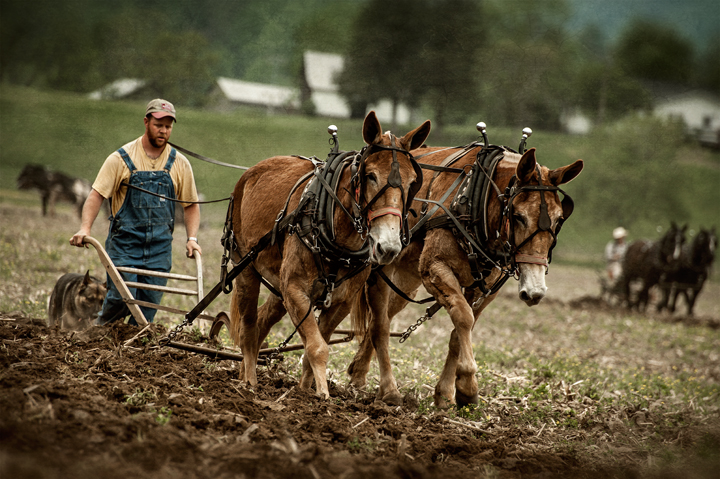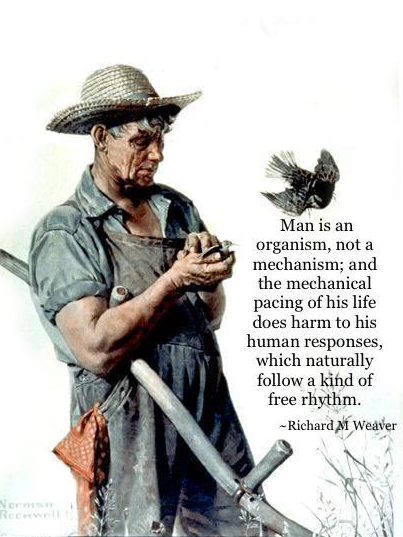“You can’t sustain current population with only human and animal powered agriculture. We need machines to feed the world.”
This is an attitude that I’ve run across more than once, and yet it seems that those who express this attitude are always unwilling to provide any reason that it should be believed. I would have liked to take the argument of someone who believes this as my starting point, but being unable to find such an argument, I have been forced to create my own. After considerable thought, the below is the most intelligent argument I can make against the idea that the world could be fed by human and animal powered agriculture (hereafter, natural-scale agriculture).
1. Natural-scale agriculture requires smaller farms than machine agriculture, which in turn means more farm families. The switch from human/animal agriculture to machine agriculture drove many farm families from their land and into the cities, and this process continues as the machinery gets bigger. A current 1,000 acre mega-farm was likely at one time 25 or more natural-scale farms. More farm families mean more farm houses and barns, which means less land in production. If a 1,000 acre mega-farm was divided into 25 natural-scale farms, that would mean 24 more houses, which might take a total of 12 acres (on the high side) out of production from the total of 1,000. Extrapolated across the board, this could mean a 1.2% reduction in farmland in production under natural-scale agriculture.
2. Natural-scale agriculture requires different farming methods. For example, natural-scale agriculture does not lend itself well to the spraying of glyophospate or herbicides on crops. While natural-scale agriculture does not preclude the use of hybrid seed per se, natural-scale farmers are far more likely to choose heirloom varieties and save their own seed. Because overhead irrigation is not available, rows must often be planted further apart to ensure each plant receives adequate water to thrive. All of this results in a lower yield per acre. According to Purdue University data, from 1866 to about 1937, US average corn yield held relatively steady at about 25 bushels per acre. In 2019, thanks to technology and machinery, average corn yield was about 170 bushels per acre.
3. Horses, mules, donkeys, oxen, and even farm hands require food. Unlike a tractor or combine, which only uses fuel when performing work, humans and animals require food at all times. If it rains for a week, and no field work can be done, humans and animals still require food, while a tractor will sit in the barn consuming nothing. The part of the farm devoted to pasture or grain for draft animals is land that is not producing food to “feed the world.”
4. Growing crops with 1/7th the yield on 1.2% less total land, and then devoting part of that land to feeding animals instead of humans would result in far less food being produced for humans. Such a reduction in the amount of food available for humans would cause widespread starvation and a failure to “feed the world.”
Hopefully this argument is not too much of a straw man. Unfortunately, it must be somewhat of a straw man, as I have been forced to create it myself. However, perhaps this article will spur discussion and provide me with other arguments to interact with.
First, natural-scale agriculture fits in smaller places than machine agriculture. In preparing for this article, I asked a current farmer who farms a very large acreage with machines what size field is the minimum size for such agriculture. He told me that 10 acres is the cutoff, and any field smaller than that is not likely worth planting in machine agriculture. However, in natural-scale agriculture, 10 acres can be an entire farm! The acre itself is a remnant of the medieval measure of the amount of land that could be plowed in one day by one man behind one ox. So for a one-ox plowman, fields as small as a a half-acre are worth plowing—its a half day’s worth of work. And human-powered agriculture, using wheel hoes, rotary cultivators, or simply hand hoes, can productively farm a much smaller field, which we tend to refer to as a garden. There are many small fields and other marginal areas that are not conducive to machine agriculture but are perfectly farmable using natural-scale methods. So natural-scale farming would increase, not decrease, the total amount of farmable land.
Secondly, the much lower yield of natural-scale agriculture would be a concern if the entire yield of machine agriculture was going to feed humans. However, this is not the case. According to the USDA, in 2019 13,620 million bushels of corn were produced. Of these, 6,257 million bushels went for “Food, Alcohol, and Industrial Use;” 30 million bushels went for Seed Use; 5,897 million bushels went for Animal Feed; and 1,778 million bushels were exported. This adds up to roughly 300 million bushels more than was produced, which was made up by using previous stores and imports.
Now lets look at the 6,257 million bushels that went for “Food, Alcohol, and Industrial Use.” Of these 6,257 million bushels, 4,857 million bushels went to “Alcohol for fuel.” In other words, 36% of the corn grown went for Ethanol fuel, which is clearly not human food and does not “feed the world.” If we convert that to acres, it means that there are 29 million acres currently farmed, but not used to grow food, and which could easily be converted to food production. However, that’s not all: 232 million bushels went for industrial starch, 419 million bushels went for high-fructose corn syrup, and 356 million bushels went for glucose/dextrose. Since none of these are foods, that’s another 6 million acres available for food production, for a total of 35 million acres.
We’ll assume that natural-scale farming would require as much seed as mechanical farming, and leave seed use alone. That brings us to the 5,897 million bushels that went for animal feed. The vast majority of this is feed for cows in commercial dairies and feedlots. In one sense, we could consider this as going towards human food and “feeding the world,” as humans eat beef and dairy products, which are more nutritious than corn. However, if we consider trophic losses, and the fact that cows can eat grass on pastures that are too steep, rocky, or otherwise featured to plant crops on, or on land that is going through a necessary fallow cycle, it becomes clear that it is unnecessary to devote prime cropland to feeding cows. This frees up another 35 million acres of cropland, bringing the total to 70 million acres.
70 million acres, when only 81 million acres of corn were harvested! 86% of the corn harvested does not go to feed people. Since only 1,859 million bushels of corn for human food were grown on 81 million acres of corn, the human food yield per acre for 2019 is 22 bushels per acre, below the average yield of 25 bushels per acre from 1866 to about 1937. Furthermore, average corn yields for natural-scale farmers today is likely much higher than 25 bushels per acre. I do not know what the figure was for 2019, but Wendell Berry cites 70 bushels per acre as the lower end of corn yields for natural-scale farmers in the late 1970’s. If you wish, you can look up the USDA data on soybeans, the 2nd largest crop in the US, and see how much of current crops go to non-food use, but I think the corn numbers alone are enough of an illustration to make the point in this article.
Finally, while draft animals do indeed eat even when not working, they are capable of subsisting entirely on pasture or hay when not working. As mentioned above, pasture and hayfields can exist on ground too steep, rocky, or otherwise featured for plowing. Once the pasture is fenced, there is no cost to letting the draft animal graze, and because cover crops and fallow cycles are necessary to responsible land use, there is very little additional cost to harvesting hay. Furthermore, oxen, donkeys, and mules are all capable of performing work on nothing but pasture/hay. Horses will require a little grain when being worked, but like the other animals, will subsist comfortably on pasture/hay when not being worked.
I realize that this article has tore down no arguments other than ones I invented myself, and which therefore are at least partly straw man arguments. However, I hope that reviewing the information has made you more sure that natural-scale agriculture is perfectly capable of feeding the world, not only at current population levels, but even at much larger ones. In conclusion, I would ask you to consider all the farmers and farm families driven off their land and into the cities by the mechanization of agriculture, depopulating rural areas. This seems to me to be the very thing the prophet condemned, and to me his words demand a reversal.
Woe to them that join house to house, and add field to field, that they may take away something of their neighbors’: Will ye dwell alone upon the land?
Isaiah 5:8

